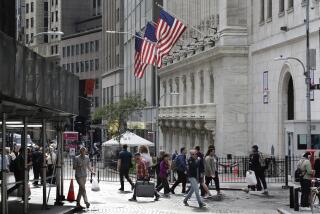Surging Crude Oil Prices Could Dampen Recovery
- Share via
Rising oil prices--which one forecaster said could soon hit $30 a barrel--threaten the fledgling economic recovery by adding unexpected costs to consumers as well as to manufacturing, transportation and other business sectors, analysts said Tuesday.
Oil prices are rising sharply because of fears that the Israeli-Palestinian conflict will boil over to cause violent unrest throughout the Middle East. A major factor contributing to nervousness is that Iraq is trying to rally Arab oil producers to embargo the United States and other supporters of Israel, in an echo of 1973 when the price of oil quadrupled, throwing the world economy into chaotic recession.
There is no evidence that Iraq’s call for embargo is succeeding, said Joseph Stanislaw, president of Cambridge Energy Research Associates. Indeed, Iraq has increased its own production by 500,000 barrels a day in response to greater demand for its particular grade of crude oil, Stanislaw said.
Also, Middle Eastern oil producing nations face high unemployment and other economic woes, making oil revenue more imperative for them today than 30 years ago.
But fear that Iraq and Iran could persuade other members of the Organization of the Petroleum Exporting Countries to cut their output, coupled with apprehension that violence could spread in the Middle East, is driving oil traders in New York and London to boost prices to six-month highs.
Oil futures for May delivery closed Tuesday at $27.71 a barrel on the New York Mercantile Exchange, up 3% on the day. The price has risen about $10 a barrel, or 55%, in the last three months. Gasoline prices have risen a comparable amount in California and most other parts of the country.
“The price could go over $30 a barrel by the weekend,” said Philip Verleger, a Newport Beach-based oil economist and senior fellow of the Council on Foreign Relations. Producers in the Persian Gulf, including the United Arab Emirates, are angry that the Bush administration has not stepped in to restrain the Israeli army’s incursion to Palestinian cities in the West Bank.
“A cutback of production would be their way of sending [President] Bush a message,” Verleger said. Saudi Arabia, the area’s largest oil producer, could not easily increase production to offset cuts elsewhere in such a politically charged atmosphere, he said.
No cuts appear to have been made so far. In March, daily output from the 11 members of OPEC rose to more than 25 million barrels a day, about 35% of total world production.
Oil prices had risen even before the crisis in Israel and the West Bank since OPEC had managed to restrain its production to support a price level of approximately $25 a barrel.
This new surge in price has come as a surprise to economists. Wells Fargo calculated earlier this year that if oil remained at $18 to $20 a barrel for the year, it would add about 0.5 percentage points to economic growth. That upbeat forecast has been tossed out, but Wells Fargo chief economist Sung Won Sohn still expects prices to decline from their present heights if Middle East tensions calm down.
“I’m hoping that supply and demand will take over and oil will settle down at about $22 a barrel,” Sohn said.
The latest price run-up “will affect consumers because it will take real purchasing power out of their pockets,” said John Felmy, chief economist of the American Petroleum Institute. A slump in energy prices last fall “allowed consumers to spend billions of dollars on things other than energy,” reducing the severity of the economic downturn, he said.
The jump in energy prices couldn’t come at a worse time for the airline industry, which already is struggling to rebound from the recession and the Sept. 11 terrorist attacks. Indeed, Continental Airlines said Monday that it could be “challenging” to turn a profit in the current quarter largely because of energy prices. The wholesale price of jet fuel has soared 40% in the last three months, reported John Armbrust, whose Armbrust Aviation Group covers the jet fuel industry.
United Parcel Service and Fed Ex Corp., two huge users of jet fuel and gasoline for their daily delivery operations, have a surcharge for fuel prices so they can pass along the higher fuel prices to customers. As for air fares, “I expect the airlines to try and get money from any source possible as long as the flying public will let them,” Armbrust said.
Higher energy prices are clouding the stronger-than-expected recovery that manufacturers have enjoyed during the last two months, said Norbert J. Ore, an Atlanta businessman with the Institute for Supply Management, which produces a closely watched monthly index of manufacturing activity.
“In terms of things to watch, energy is one of my biggest concerns right now,” said Ore, who is a purchasing executive for Georgia-Pacific Corp., which buys close to $1billion a year of petroleum products for its manufacturing processes. “We get these price spurts and it functions much like a tax increase because it pulls a lot of money out of the economy.”
The main question businesspeople are asking now is whether today’s high prices will hold for a long time. If there were attempts to cut production and embargo the U.S. and other markets, as Iraq is proposing, other suppliers such as Russia, Mexico and Venezuela could deliver a few million barrels a day in increased production to the world, Stanislaw of Cambridge Energy explained. That would not be a great deal compared to the Persian Gulf’s output, which amounts to 21% of the world’s demand and 24% of U.S. imports.
Yet embargos and OPEC cutbacks would only occur if Middle East tensions rose dramatically. “Saudi Arabia and other states would think a million times before they would embargo the United States,” Stanislaw said. The first embargo in 1973 caused the U.S. and other industrial countries to increase their discovery and production of alternative sources of oil and to make their own economies less energy dependent.
“The technology exists today to really shift our energy sources,” Stanislaw said, referring to advances in fuel cells for automobiles and other pending technologies.
Indeed, although energy prices are up, “we’re still in better shape than we were a year ago at this time,” Felmy said. Oil, gasoline and natural gas prices were higher, inventories were lower and California was suffering through electricity blackouts, he said.
Sohn also pointed out that the U.S. economy was about eight times more sensitive to energy price volatility in 1973, during the first Arab oil embargo.
More to Read
Sign up for Essential California
The most important California stories and recommendations in your inbox every morning.
You may occasionally receive promotional content from the Los Angeles Times.











